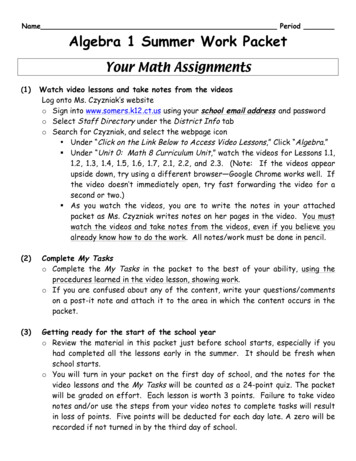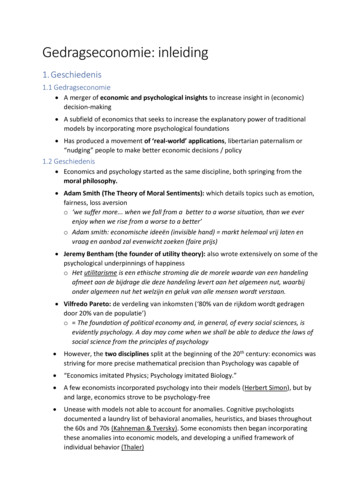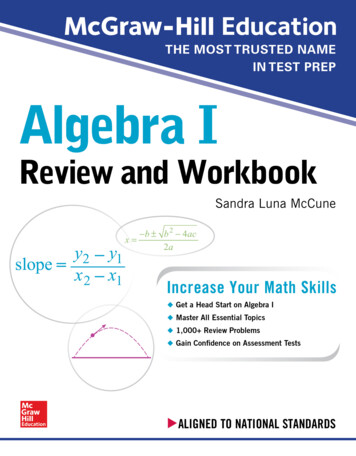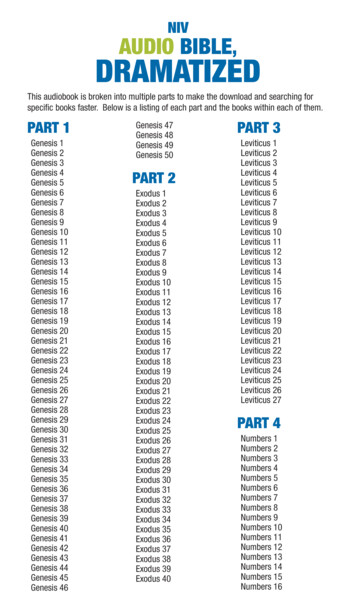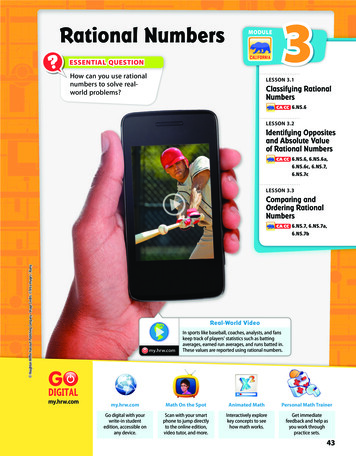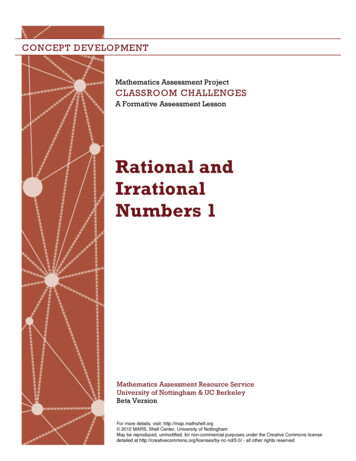
Transcription
CONCEPT DEVELOPMENTMathematics Assessment ProjectCLASSROOM CHALLENGESA Formative Assessment LessonRational andIrrationalNumbers 1Mathematics Assessment Resource ServiceUniversity of Nottingham & UC BerkeleyBeta VersionFor more details, visit: http://map.mathshell.org 2012 MARS, Shell Center, University of NottinghamMay be reproduced, unmodified, for non-commercial purposes under the Creative Commons licensedetailed at http://creativecommons.org/licenses/by-nc-nd/3.0/ - all other rights reserved
Rational and Irrational Numbers 1MATHEMATICAL GOALSThis lesson unit is intended to help you assess how well students are able to distinguish betweenrational and irrational numbers. In particular, it aims to help you identify and assist students who havedifficulties in: Classifying numbers as rational or irrational.Moving between different representations of rational and irrational numbers.COMMON CORE STATE STANDARDSThis lesson relates to the following Standards for Mathematical Content in the Common Core StateStandards for Mathematics:N-RN: Use properties of rational and irrational numbers.This lesson also relates to the following Standards for Mathematical Practice in the Common CoreState Standards for Mathematics:3.Construct viable arguments and critique the reasoning of others.INTRODUCTIONThe lesson unit is structured in the following way: Before the lesson, students attempt the assessment task individually. You then review students’work and formulate questions that will help them improve their solutions.The lesson is introduced in a whole-class discussion. Students then work collaboratively in pairsor threes to make a poster on which they classify numbers as rational and irrational. They workwith another group to compare and check solutions. Throughout their work students justify andexplain their decisions to peers.In a whole-class discussion, students revisit some representations of numbers that could be eitherrational or irrational and compare their classification decisions.Finally, students work individually to show their learning using a second assessment task.MATERIALS REQUIRED Each individual student will need a mini-whiteboard, an eraser, a pen, and a copy of theassessment task Is it Rational?Choose how to end the lesson. Either provide a fresh copy of the assessment task, Is it Rational?for students to review and improve their work, or provide a copy of the assessment task,Classifying Rational and Irrational Numbers.For each small group of students provide a copy of the task sheet Poster Headings, a copy of thetask sheet Rational and Irrational Numbers, a large sheet of poster paper, scrap paper, and a gluestick.Have calculators and several copies of the Hint Sheet available in case students wish to use them.Either cut the resource sheets Poster Headings, Rational and Irrational Numbers, and Hint Sheetinto cards before the lesson, or provide students with scissors to cut-up the cards themselves.You will need some large sticky notes and a marker pen for use in whole-class discussions.There are also some projector resources to help with whole-class discussion.TIME NEEDED15 minutes before the lesson for the assessment task, a 1-hour lesson, and 10 minutes in a follow-uplesson (or for homework). All timings are approximate, depending on the needs of your students.Teacher guideRational and Irrational Numbers 1T-1
BEFORE THE LESSONAssessment task: Is it Rational? (15 minutes)Have the students do this task in class or for homework aday or more before the formative assessment lesson. Thiswill give you an opportunity to assess the work, andidentify students who have misconceptions or need otherforms of help. You should then be able to target your helpmore effectively in the follow-up lesson.Rational and Irrational Numbers 1Student MaterialsAlpha Version June 2011Is it Rational?Remember that a bar over digits indicate a recurring decimal number. E.g. 0.256 0.2565656.1. For each of the numbers below, decide whether it is rational or irrational.Explain your reasoning in detail.!5!570.575!Give each student a copy of Is it Rational? Introduce thetask briefly, and help the students understand what theyare being asked to do.!!!Spend 15 minutes answering these questions.55 71025.75.I’d like you to work alone for this part of the lesson.!!Show all your work on the sheet, and make sure youexplain your answers really clearly.(5 5)(5" 5)(7 5)(5" 5)!I have some calculators if you wish to use one.! 2011 MARS University of Nottingham UKS-1It is important that, as far as possible, students answer the questions without assistance. Help studentsto understand that they should not worry too much if they cannot understand or do everythingbecause, in the next lesson, they will work on a related task that should help them make progress.Assessing students’ responsesCollect students’ responses to the task. Make some notes on what their work reveals about theircurrent levels of understanding and any difficulties they encounter. The purpose of this is to forewarnyou of the issues that will arise during the lesson, so that you may prepare carefully.We suggest that you do not score students’ work. The research shows that this is counterproductive,as it encourages students to compare scores and distracts their attention from how they may improvetheir mathematics.Instead, help students to make progress by asking questions that focus attention on aspects of theirwork. Some suggestions for these are given in the Common issues table on the next page. These havebeen drawn from common difficulties observed in trials of this unit.We suggest that you write your own lists of questions, based on your own students’ work, using theideas below. You may choose to write questions on each student’s work. If you do not have time todo this, select a few questions that will be of help to the majority of students. These can be written onthe board at the end of the lesson.Teacher guideRational and Irrational Numbers 1T-2
Common issues:Suggested questions and prompts:Student does not recognize rational numbersfrom simple representations A rational number can be written as a fractionof whole numbers. Is it possible to write 5 asa fraction using whole numbers? What about0.575? Are all fractions less than one?For example: The student does not recognizeintegers as rational numbers.Or: The student does not recognize terminatingdecimals as rational.Student does not recognize non-terminatingrepeating decimals as rationalFor example: The student states that a nonterminating repeating decimal cannot be writtenas a fraction.Student does not recognize irrationalnumbers from simple representationsFor example: The student does not recognize 5is irrational.Student assumes that all fractions are rational!For example: The student claims102is rational.Student does not simplify expressionsinvolving radicals!For example: The student assumes Use a calculator to find19, 29 , 39 as adecimal. What fraction is 0.8 ?! ! is 1 ? What kind of!decimal3! Write the first few square numbers. Onlythese perfect square integers have whole! roots. So which numbers cannumber squareyou find that have irrational square roots? Are all fractions rational? Show me a fraction that represents arational/irrational number? What happens if you remove the parentheses? Are all expressions that involve a radicalirrational?(5 5)(5" 5) is irrational because there is anirrational number in each bracket.!Student does not recognize that somerepresentations are ambiguous.For example: The student writes that 5.75. isrational or that it is irrational, not seeing that5.75. is a truncated decimal that could continuein ways that represent rational numbers (such as!!5.75 ), and that represent irrational numbers(non-terminating non-repeating decimals). The dots tell you that the digits wouldcontinue forever, but not how. Write anumber that could continue but does repeat.And another And another Now think about what kind of number thiswould be if subsequent digits were the samethe decimal expansion of π.!Teacher guideRational and Irrational Numbers 1T-3
Common issues:Suggested questions and prompts:Student does not recognize that repeatingdecimals are rationalFor example: The student agrees with Arlo that0.57 is an irrational number.Or: The student disagrees with Hao, claiming!! How do you writeWhat about4913as a decimal? Does every rational number have a! decimal expansion?terminating!0.57 cannot be written as a fraction.Student does not know how to convertrepeating decimals to fraction formFor example: The student makes an error whenconverting between representations (Q2b.)Student does not interpret repeating decimalnotation correctlyFor example: The student disagrees with Korbin,who said that the bar over the decimal digitsmeans the decimal “would go on forever if youtried to write it out.”Student does not understand that repeatingnon-terminating decimals are rational, andnon-repeating non-terminating decimals areirrationalFor example: The student agrees with Hank, thatbecause 0.57 is non-terminating, it is irrational,and does not distinguish non-repeating fromrepeating non-terminating decimals.Student explanations are poorFor example: The student provides little or noreasoning.Teacher guide What is the difference between 0.57 and 0.57 ?1 How do you write 2 as a decimal? How would you write 0.5 as a fraction? Explain each stage of these calculations:7! x 0.7 , 10x 7.7 , 9x 7 , x 9 . Remember that a bar indicates that a decimalnumber is repeating. Write the first ten digitsof these numbers: 0.45 , 0.345 . Could youfigure out the 100th digit in either number? How do you writeWhat about13as a decimal?4?9 Does every rational numbers have a! decimal expansion?terminating Does! every irrational number have aterminating decimal expansion? Which non-terminating decimals can bewritten as fractions? Suppose you were to explain this to someoneunfamiliar with this type of work. How couldyou make this math clear, to help the studentto understand?Rational and Irrational Numbers 1T-4
SUGGESTED LESSON OUTLINEIntroduction to Classifying Rational and Irrational Numbers (10 minutes)Give each student a mini-whiteboard, a pen, and an eraser. Use these to maximize participation in theintroductory discussion.Explain the structure of the lesson to students.Recall your work on irrational and rational numbers [last lesson].You’ll have a chance to review that work later today.Today’s lesson is to help you improve your solutions.Explain to students that this lesson they will make a poster classifying rational and irrational numbers.Display the projector resource Classifying Rational and Irrational Numbers on the board.Classifying Rational and Irrational NumbersRational NumbersIrrational NumbersTerminatingdecimalNon-terminatingrepeating r ResourcesRational and Irrational Numbers 1P-1I’m going to give you some headings and a large sheet of paper.You’re going to use the headings to make this classification poster.Then you’re going to get some cards with numbers on them. You have to decide whether thenumber is rational or irrational, and where it fits on your poster.You will classify these examples of rational and irrational numbers.Check students’ understanding of the terminology used for decimal numbers:On your whiteboard, write a number with a terminating decimal.Can you show a number with a non-terminating decimal on your whiteboard?Show me a number with a repeating decimal.Show me the first six digits of a non-repeating decimal.Write 0.123 on a large sticky note. Model the classification activity using the number 0.123 .0.123 . Remind me what the little bar over the digits means. [It is a repeating decimal that begins0.123123123. ; the digits continue in a repeating pattern; it does not terminate.]In which row of the table does 0.123 go? Why? [Row 2, because the decimal does not terminatebut does repeat.]Ok. So this number is a non-terminating repeating decimal because the bar shows it has endlessrepeats of the same three digits. [Write this on the card.]Show me on your whiteboard: isTeacher guide0.123rational or irrational? [Rational.]Rational and Irrational Numbers 1T-5
Students may offer different opinions on the rationality of 0.123 . If there is dispute, accept students’answers for either classification at this stage in the lesson. Make it clear to students that the issue isunresolved and will be discussed again later in the lesson.Explain to students how you expect them to collaborate. Display the slide Instructions for PlacingNumber Cards.Here are some instructions for working together.Take turns to choose a number card.When it’s your turn, decide where your number card fits on the poster, and see if it fits in just oneplace or in more than one place. Explain your decision to your partner.When it is your partner’s turn, decide whether you agree or disagree with what she’s said. If youagree with your partner’s decision, explain her reasons in your own words. If you disagree,explain why. Then, together, figure out where to put the card.When you have reached an agreement, write reasons for your decision on the number card. If thecard fits in just one place, put it on the poster. If not, put it to one side. Remember, there are somecards that could go in more than one category. Keep these cards separate.All students in your group should be able to give reasons for every placement.Don’t glue things in place or draw in the lines on the poster yet, as you may change your mindlater.Collaborative small-group work (20 minutes)Organize students into groups of two or three. For each group provide the sheet Poster Headings, thesheet Rational and Irrational Numbers, a large sheet of paper for making a poster, and scrap paper.Do not distribute the glue sticks yet.Students take turns to place cards, and collaborate on justifying these placements. Once they haveagreed on a placement, the justification is written on the card and either placed on the poster or to oneside.During small group work, you have two tasks: to find out about students’ work, and to support theirthinking.Find out about students’ workListen carefully to students’ conversations. Note especially difficulties that emerge for more than onegroup.Do students assume that all fractions represent rational numbers? Do students manipulate theexpressions involving radicals to show that the number represented is rational/irrational? Or do theyevaluate the expressions on a calculator? Figure out which students can convert a non-terminatingrepeating decimal to a fraction. Do students identify all the meanings of ambiguous expressions suchas ‘0.123 rounded correct to 3 decimal places’?Listen for the kind of reasoning students give in support of their classifications. Do they usedefinitions? Do they reason using analogies with other examples? You can use what you hear toidentify students to call on in the whole-class discussion and, in particular, find two or three cards as afocus for that discussion.Support student thinkingIf you hear students providing incorrect classifications or justifications, try not to resolve the issuesfor them directly. Instead, ask questions that help them to identify their errors and to redirect theirTeacher guideRational and Irrational Numbers 1T-6
thinking. You may want to use some of the questions and prompts from the Common issues table. Ifstudents are relying on a calculator to place the cards, encourage them to explain the answersdisplayed on it.If a student struggles to get started, encourage them to ask a specific question about the task.Articulating the problem in this way can sometimes offer ideas to pursue that were previouslyoverlooked. However, if the student needs their question answered, ask another member of the groupfor a response. There is a Hint Sheet provided to help students who struggle to make progress inclassifying these numbers: 0.123,3,4the calculator display 3.14159265, and 0.9 .If one group of students has difficulty with a problem another group dealt with well, you could askthem to talk to each! other. If several groups of students are finding the! same issue difficult, you mightwrite a suitable question !on the board, or organize a brief whole-class discussion focusing on thataspect of mathematics.Are all fractions rational? Show me a fraction that is rational/that is irrational.What does a calculator display 0.7777777778 / 0.1457878342 tell you about the number?Is any number with a root sign irrational?Prompt students to write reasons for their decisions next to the cards. If you hear one studentproviding a justification, prompt the other members of the group to either challenge or rephrase whatthey heard.If any groups finish early, ask them to use the blank card to try to make up a new number to fit in anempty cell on the poster.A couple of minutes before the end of the activity, ask each group to write onto a sheet of scrappaper, the numbers from cards they have decided not to place on the poster.Comparing solutions (10 minutes)Ask one student from each group to swap with a student in another group, taking with them the sheetof scrap paper on which they have written their group’s non-classified numbers.In the new groups, students compare the numbers they have not classified, to see if there are anydifferences. Ask students to share their reasons for the numbers they have not classified.Gluing posters (5 minutes)Ask students to return to their original small groups, and distribute glue sticks. Ask them to discusswith their partners any changes they might want to make. Once students are satisfied with theiranswers, they can glue the cards in place. Remind students not to put on the poster any number cardsthey think can go in more than one place.While students work on this, think about the numbers your students found it difficult to place, ornumbers about which you know there are different solutions. You can use these numbers as a focusfor the whole-class discussion. Write these numbers in marker pen on large sticky notes.Whole-class discussion (15 minutes)In this discussion, we suggest you focus on reasoning about one or two examples that students founddifficult, rather than checking students all have the same classification.Check that each student has a mini-whiteboard, a pen, and an eraser. Display the slide ClassifyingRational and Irrational Numbers again. Use the numbers you wrote on sticky notes: you will be ableTeacher guideRational and Irrational Numbers 1T-7
to move them from one position to another on the classification table until students have reachedagreement about proper placement.Choose one of your sticky notes, and read it to students. Ask students to write on their miniwhiteboards where to place it on the classification table. Place your sticky note on the part of the tableindicated by one student and ask them to justify their placement of the card. Now ask another studentto comment on the justification. Call on students who gave different answers on their whiteboards.Bradley, where did you place this card? What was your reasoning?Do you agree, Lia? You do? Please explain Bradley’s answer in your own words.Kanya, can you tell us why you think differently?Move the cards from one cell to another until students reach agreement on the placement of the card.If there is no disagreement, provoke some by placing a number incorrectly and asking students for anexplanation.The discussion below is indicative. You may feel that other issues should be the focus of discussionfor your students.Sample discussionYou might begin by checking the placement of the non-terminating repeating decimal 0.123 .Write on your mini-whiteboard. IsIs0.1230.123terminating or non-terminating?rational or irrational?Alicia, where did you place 0.123 ? Why might you think it goes there?As part of this discussion, you might ask students to show on their mini-whiteboards how to changefrom the repeating non-terminating decimal representation to a fraction. If necessary, ask students towork with you, as you model use of the standard algorithm for changing a repeating decimal to afraction.Focus on the decimal representations 0.123 , 0.123 , 0.123. , 0.123 , and 0.123 (rounded correct tothree decimal places). To actively involved students, ask them to use their mini-whiteboards.Are 0.123 and 0.123 the same number? How do you know?Is 0.123 rational or irrational? How do you know?What about 0.123? Is that rational or irrational? How do you know?What is the difference between 0.123 and 0.123. ? What difference do those little dots [theellipsis] make?!Show me a way 0.123. might continue if it’s a rational number.Show me a way 0.123. might continue that would make it an irrational number. Why is thisdifficult?Push students to identify explicitly the difference between decimals in which there is a repeatingpattern of digits, and non-terminating decimals in which there is a pattern, but no repeats.Either refer to one of the student’s whiteboards, or write 0.123456789101112131415. on the board.What would the next six digits be, Jenny? How do you know?Tell me about the pattern in the digits of this decimal number.Is this a repeating decimal?Do the same digits repeat in the same order again and again?Teacher guideRational and Irrational Numbers 1T-8
Consider the other ambiguous representations:What if the number is rounded to 0.123 ? Is this a rational or an irrational number?Show me a number that could be rounded to 0.123 that is a rational number.Show me a number that could be rounded to 0.123 that is an irrational number.Did you find any other representations that might be rational, or might be irrational, dependingon how the number continued? [The calculator display looks like the first digits of pi, but couldbe a rational number.]Explain how the calculator display number might continue.Show me a rational version of the calculator display number.If there is time, consider 0.9 and how, as this can be written as 1, the distinction between terminatingand non-terminating decimal representations becomes blurred.Finally, discuss the empty cells on the classification table (irrational terminating decimal, irrationalnon-terminating!repeating decimal, rational non-terminating non-repeating decimal).Which numbers go in this cell?Is it possible to place numbers in this cell? [No. No terminating decimals/non-terminatingrepeating decimals are irrational numbers, and no non-terminating non-repeating decimals arerational numbers.]Next Lesson: Reviewing the lesson (10-15 minutes)Decide whether you want students to review their initial assessment tasks or work on a new, relatedtask.Reviewing individual solutions to the assessment task, Is it Rational? (10 minutes)Give each student his or her original solution to the assessment task, Is it Rational? along with a newcopy of the same task.Invite students to revise their work using your questions.I would like you to read through your original solutions, and think about what you have learnedthis lesson. I wrote questions to help you improve your work. Think about what you learned [lastlesson], then write a new solution using what you learned.If you have not added questions to individual pieces of work, then write your list of questions on theboard. Students should select from this list only those questions they think are appropriate to theirown work.Assessment task: Classifying Rational and Irrational Numbers (20 minutes)Give each student a copy of the assessment task, Classifying Rational and Irrational Numbers.I’d like you to recall the work you did on rational and irrational numbers last lesson.Spend 15 minutes answering these questions.I’d like you to work alone for this part of the lesson.Show all your work on the sheet and make sure you explain your answers really clearly.I have some calculators if you wish to use one.Teacher guideRational and Irrational Numbers 1T-9
SOLUTIONSAssessment task: Is it Rational?1.NumberPossible student reasoning55 is rational.It can be written as a fraction, the ratio of two integers a, b, with b " 0, e.g.Students sometimes discount whole number rationals, especially 0.5757is rational, since it can be written as the ratio of two integersa, b, with b " 0.!! !0.575 is rational.0.575!Using decimal place value, 0.575 !!5!!575.1000!5 is irrational.Students might argue! that if a number is not a perfect square then its root isirrational. Or they might argue that 4 9 , and there is no integer between 2!and 3. This doesn’t establish that there is no fractional value for, though. Atthis stage of their math learning, students are unlikely to produce a standard proofby contradiction of the irrationalityof!! 5.5 7 is irrational because the sum of a rational and irrational number is alwaysirrational.!5 710!2!35 "5,.7 "110is irrational.2Students may think it is rational because it is represented as a fraction.!5.75.!!!5.75. From this truncated decimal representation, it is not possible to decidewhether the number represented by 5.75 is rational or irrational.This is a difficulty that students often encounter when reading calculator displays.The dots here indicate that the decimal is non-terminating, but the number mighthave a repeating (rational) or non-repeating(irrational) tail. Students could giveexamples to show this, e.g. 5.757 and 5.75123456789101112131415 .(5 5)(5" 5)The product of these two irrational factors is rational. Using a calculator willsuggest that the product is rational, but not why.!(5 5)(5 " 5) 25 " 5 5 5 5 " 5 20 . Removing the parentheses and simplifyingdoes provide a reason why the expression is rational.(7 5)(5" 5)The product of these two irrational factors is irrational.(7 5)(5 " 5) 35 " 7 5 5 5 " 5 30 " 2 5 .!!Since 5 is irrational, 2 5 is irrational, and 30 " 2 5 is irrational. Use of acalculator will not help to show the irrationality of 30 " 2 5 .!!Teacher guide!!!Rational and Irrational Numbers 1!T-10
2.StudentStatementAgree ordisagree?Arlo:0.57 is an irrational number.DisagreeAgreeing with Arlo, that 0.57 is anirrational number, may indicate a standardmisconception. Many students believe thata number with an infinitely long decimalrepresentation must be irrational.Hao:No, Arlo, it is rational, because 0.57can be written as a fraction.AgreeHao is correct.Maybe Hao’s correct, you know.Agree withstatement,butdisagreewithreason.Eiji is correct in that Hao’s answer iscorrect, but he is incorrect to say that57. This is a common error.0.57 100Eiji:Because 0.57 57.1000.57 1933Korbin:Hang on. The decimal for 0.57would go on forever if you tried towrite it out. That’s what the bar thingmeans, right?Agree0.57 0.57575757. does “go onforever.” Not recognizing this is amisunderstanding of standard notation.Hank:And because it goes on forever, thatDisagreeThinking that an infinitely long decimaltail means a number can’t be rational is acommon student error.proves 0.57 has got to be irrational.2.b. 0.57 is rational.57 19Let x 0.57 . Then 100x 57.57 . So 99x 57 . Thus x . 99 33!Teacher guideRational and Irrational Numbers 1T-11
Collaborative small-group workTerminatingdecimalRational numbersIrrational numbers7 0.875 and is a terminating decimal.8This cell is empty: there areno terminating decimalrepresentations of irrationalnumbers.0.123 !123and so rational and terminating.10002(8 2 )(8 " 2 ) 64 " 8 2 8 2 " 2 64 " 2 62.!!62 rational, with a terminating decimal representation.82 2 22! 22 is rational, with a terminating decimal representation.!2 " 8 2 "2 2 2"2 44 is rational, with a terminating decimal representation.Non- !terminatingrepeatingdecimal!!2 0.63Students might already know this decimal conversion, orperform division to calculate it.This cell is empty: there areno non-terminating repeatingdecimal representations ofirrational numbers.22 3.1428977Students might use division to calculate this commonlyused approximation of π. Using a calculator, they maynot find all the repeating digits, and so would have noreason to suppose it is a repeating decimal.x 0.1231000x 123.1231000x ! x 123999x 123x 0.123 123999x 0.12310x 1.231000x ! 10x 12212261x 990495Teacher guide1000x 123.23Rational and Irrational Numbers 1T-12
NonterminatingnonrepeatingdecimalRational numbersIrrational numbersThis cell is empty: no rationalnumber has a non-terminatingnon-repeating decimalrepresentation.!" is irrational, with a non-terminating, non-repeatingdecimal representation. We expect students will havebeen told of the irrationality of " , and do not expectthis claim to be justified.3 is irrational since 3 is not a perfect square, and only!4integers that are perfect squares have rational roots. Anirrational divided by a rational is irrational.8 is irrational since 8 is not a square number, andonly integers that are square numbers have rationalroots.!!2 8 is the sum of two irrational numbers. It isirrational, since 2 8 2 2 2 3 2 and theproduct of a non-zero rational number and an irrationalnumber is irrational. Some sums of irrational numbersare rational,such as 4 2 " 2 8 .!There is insufficient information to assign the following numbercards to a unique category:!0.123 .This is a non-terminating decimal, but the ellipsis does not determine whether it is repeating ornon-repeating.It could turn out to be a rational number, such as 0.1234 .It could turn out to be an irrational number, such as 0.12301001000100001 (a patterned tail ofzeros and ones, with one extra zero between ones each time.)0.123 (rounded correct to three decimal places) and the calculator display: 3.141592650.123 could be a rounded version of either a rational or an irrational number, because it might bea rounded terminating decimal, rounded non-terminating repeating decimal (both rational), or anon-te
Student does not recognize rational numbers from simple representations For example: The student does not recognize integers as rational numbers. Or: The student does not recognize terminating decimals as rational. A rational number can be written as a fraction of wholenumbers.Is it possible to write 5as a fraction using whole numbers?
